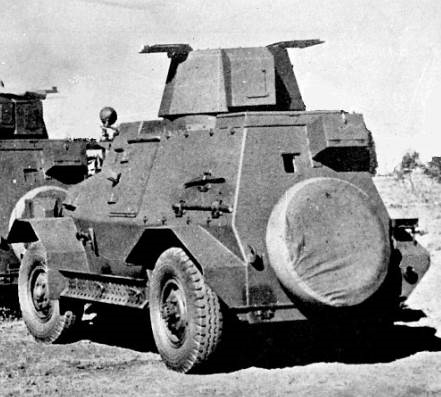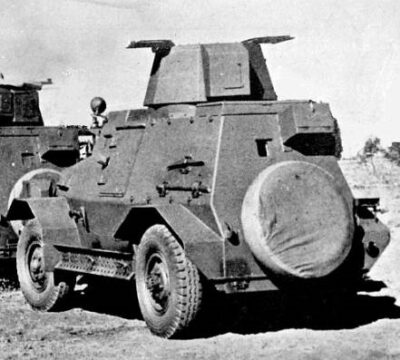In addition to our French and German Collections, the Weald Foundation set out to build a collection of AFVs produced during the Second World War in parts of the British Empire, namely Australia, South Africa and India to correct the conventional narrative of the significant contribution these countries, previously within the old British Empire, made towards the Allied victory in WWII over the Axis.
In the summer of 2018, two South African Reconnaissance Car Mk III “Marmon-Herrington” were added to our “Empire Collection”. Given that these armoured cars were designed and assembled in South Africa during the Second World War, they met our collection criteria perfectly.
The South African Reconnaissance Car (SARC) Mk III was the most numerous of these armoured vehicles produced. This armoured car- commonly referred to as the Marmon-Herrington, for reasons covered later, this vehicle saw action in East Africa and later North Africa.
As we had two Marmon Herrington Mk IIIs, our initial thought was we could use one of them as a donor. However, this idea soon evaporated, when we realised that our two vehicles represented an early SARC Marmon-Herrington Mk III and a much later variant of the Mk III. This now presented us with an exciting challenge, as we were not aware of any other surviving example of the earlier SARC Marmon-Herrington Mk III.
Ongoing research is currently being carried out, while we complete our Sd.Kfz.222, Sd.Kfz.223 and Sd.Kfz.261 restorations.
One of the key sources of our early research is William Marshall himself and his excellent book 'Marmon Herrington A History of the South African Reconnaissance Car'. We also continue to push forward with our own primary research working through the various archives. One of the issues we face is that the Marmon-Herrington survivors are nearly exclusively Mk IVs. Apart from some examples of Mk IIIs in Southern Africa, there are no MK III (or earlier) combat veterans in the Northern Hemisphere to stir up a fan base. The consequence of this is the SARC Marmon-Herrington is not well known or followed. So the only other source of information relies on a number of hazy black-and-white images from the Second World War.
Original archive information confirms that the chassis and components for the South African Reconnaissance Car Marmon Herrington Mk III were imported from Ford Canada with the front axle, transfer case and 4-wheel drive steering provided by the Marmon Herrington Company of Indiana. This collaborative truck chassis was termed at the time by Ford as 'All-wheel drive Marmon Herrington converted Fords'. The chassis and components were shipped to South Africa and sent to Ford in Port Elizabeth for assembly
If Marmon-Herrington was only responsible for the components used in the conversion of the Ford chassis, why then is that company name is synonymous with the South African Reconnaissance car?
Examination of the Foundations South African Reconnaissance Car Mk III reveals an interesting if often overlooked angle. The only externally visible trade or assemblers’ identity is the rather ornate Marmon-Herrington motif on each wheel hub of the front axle that was, of course, purchased from Marmon-Herrington. The first two with red paint residue are from the earlier MK III and the last two are from the MK III late.
Returning to William Marshall’s fine book on the South African Reconnaissance Car William dedicates a page to tackle the naming subject. His research has shown him that the official documentation at the time only used the name South African Reconnaissance Car Mk I and Mk II (abbreviated to SA Recce Mk I and II). But some time there after all versions were referred to a Marmon-Herrington.
From other sources, there is the suggestion that the British added the identifier Marmon-Herrington to their description when the they took delivery of these armoured cars in exceptionally large numbers.
The engine in the earlier Mk III, is an aluminium-head Ford flat head V8.
Completion of the upper superstructure will prove a challenge but what is fortunate is that the superstructure is a skeleton of angle iron and flat bar (the frame) to which the armour plate is fixed to form the armoured hull. The existing angles provide the most difficult structural answers. Due to no known survivors of this early Marmon Herrington Mk III, there may well be difficulties in checking exact physical details.
We are fortunate to have a near complete chassis, we were missing some key components such as the transfer case of which two have recently arrived from Australia.
The discovery of hull registration, chassis number and U registration number, has allowed us to position the assembly date of the early Mk III. This can now be revealed as being assembled in approximately October 1941.
The exact hue of “Light Stone” has yet to be comprehensively established to allow the Foundation to replicate the colour as applied in 1941. The “Light Stone” discussion centres only the earlier SARC Mk III. This was the only SARC ‘Marmon Herrington’ that yielded any residue of Light Stone within the paint remaining on the hull.


